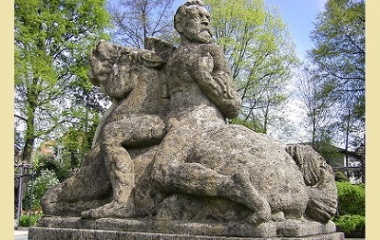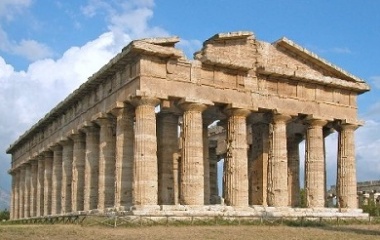- Pronunciation: nep-t-yoon
- Origin: Rome
- Role: Ruler of the sea and earthquakes
- Parents: Saturn, Ops
- Siblings: Jupiter, Pluto, Juno, Ceres, Vesta
- Wife: Salacia
- Children: The merman Triton, sea nymphs Rhode and Benthesicyme, and many others
- Symbols: Trident, horse, dolphin, bull
- Greek counterpart: Poseidon
Who Is Neptune
When the jurisdictions of the ancient Roman world were divided among the three brothers Jupiter, Neptune and Pluto, it was decided that the ill-tempered and violent Neptune would preside over the sea. His nature is representative of the turbulence of his domain of the ocean waters and the earthquakes.
Similarly to his Greek counterpart, Poseidon, he was lustful and enjoyed the sexual company of goddesses, sea nymphs and mortal women. He even craved the attentions of his own sister Ceres, who hid from him by turning herself into a mare. Neptune transformed himself into a horse to rape her. This resulted in the birth of a daughter as well as a black mare. Neptune was at times also worshipped as a horse god and the patron of horse racing referred to as Neptune Equester.
He served as a member of the Dei Consentes, the 12 major gods and goddesses of the Roman pantheon.
Origin
After Gigantomachy, the Great War with the giants, Neptune’s brother Jupiter had overthrown their father Saturn as ruler and the three brother gods, Jupiter, Neptune and Pluto were charged with ruling the worlds. Jupiter took the sky, Neptune became ruler of the sea and Pluto’s domain was the underworld. Eventually, Jupiter became the supreme god who ruled all of the Earth and sky, while Neptune married Salacia and stayed in the sea, and Pluto went to the underworld where he presided over the afterlife.
Neptune had a reputation for having a violent temper and lustful nature. Ocean storms and earthquakes were a reflection of his demeanor. Considering his difficult beginnings, it’s no wonder that Neptune had a temperamental personality. Saturn ate him whole along with his siblings, to avoid the possibility of any of the offspring seizing his ruling status, although eventually this plot was ineffective. Saturn was killed by Jupiter and the sons did achieve ruler status, at which time Neptune took over the sea.
Marriage of Neptune
The story of the courtship of Neptune and Salacia (counterpart of the Greek Amphitrite) started on the island called Naxos in the Aegean Sea. Salacia was dancing with her sisters, and the moment Neptune saw her, he decided he wanted her as his wife. Unfortunately for the love-struck god, the goddess wasn’t interested in his proposal or giving up her life as a sea virgin and she ran off to the Atlas mountains to hide.
Being the persistent type, Neptune summoned Delphinus, the dolphin king, to find the goddess and persuade her to marry him. The smart and gentle natured dolphin set off on the mission. After weeks of searching finally found her. The dolphin was such a lovely creature that Salacia was drawn to him and listened to his persuasion. Delphinus explained that her steadiness would balance the volatile nature of Neptune and if she married him there would be harmony in the sea and joy for all. As a reward for bringing his bride, the god placed an image of Delphinus in the heavens. The constellation is located on the northern sky close to the celestial equator.
Neptune and Salacia had three children together, Benthesicyme, the nymph of the waves, Rhodes, the namesake of the island, and Triton the infamous merman and fabled father and leader of 3000 mermaids, and 3000 triton (merman).
Once they were actually married, the sea god went back to his usual ways and had numerous affairs with other goddesses, nymphs and mortals.
Medusa
Medusa was originally an exceptionally beautiful young woman with gorgeous, flowing, blond hair. She was desired by many but before she had a chance to choose a suitor for marriage, the lascivious Neptune found her worshipping in the temple of Minerva (goddess of wisdom) and raped her.
As punishment for violating the grounds of her sacred temple, Minerva turned Medusa’s golden tresses into snakes and going forth from that day, anyone who gazed directly at her would turn to stone.
Symbols
The sea god is most commonly depicted as a bearded man holding a trident and riding a sea shell chariot drawn by sea-horses. The cross at the lower end of the trident symbol stands for the root of things, the essence of nature. The three prongs can be interpreted to have various meanings including birth, life and death, or mind, body and spirit.
The trident also represented his ability to control the waters. It was originally created by the Cyclopes before the war between the Olympians and Titans.
Also representing the sea god is the horse, as it was believed that he created the very first one. The horses pulling his sea shell chariot are called Hippocamps.
Another closely related symbol is the dolphin as it reflects Neptune’s abilities to move in and out of the water. He is often shown surrounded by dolphin, fish, whales and other sea creatures.
The bull remains a symbol of Neptune and a nod to his counterpart, Poseidon of Greece. This is reminiscent of the myth of the Cretan bull, father of the magical creature the Minotaur. When Poseidon sent a pure white bull to the King of Crete as a sign, it was meant to be subsequently sacrificed in the honor of the god of the sea. However, the bull was so fine a specimen, that the king couldn’t bear the idea of killing it, and swapped it for an inferior earthly bull to sacrifice. Furious at this outrage, the love goddess was called upon by Poseidon to put a spell on the queen, who fell in love with the white bull and bore the Minotaur child.
Historical Influence
Neptune was honored with two temples in Rome. The first was located near the Circus Flaminius, the horse racetrack. The second temple, the Basilica of Neptune near the site of the Roman Pantheon, was built by the statesman Marcus Vipsanius Agrippa to celebrate his naval victories.
In Homer’s Odyssey, Neptune delayed the return of Odysseus from the Trojan War by causing his ship to wreck.
Neptunalia was a festival held in honor of Neptune on July 23rd each year. In the midst of the dry, hot season, the Romans sought the protection of their irrigated waters. Bulls were sacrificed to Neptune and little huts were built to provide shade for the people to picnic under.
Modern Influence
The characteristics and role of Neptune are mostly congruent with his Greek counterpart and predecessor Poseidon. However, in Western culture, Neptune is the mythological deity most commonly related to all things pertaining to the waters.
The god of the seas is the subject of many works of art and statues in Italy and throughout the world. Many replicate the Fountains of Neptune in Florence located in front of the Palazzo Vecchio, (town hall) or the fountains in Rome or Bologna.
Neptune was the name given to the eighth planet from the sun, discovered in 1846. Shortly after the discovery of the planet, its largest moon was also observed and was named for his son, Triton.











We have to do a project on Gods and mine is Neptune
I like learning about gods!
great info. excellent writing
I was always taught that Medusa was evil until I read this. Thank you for writing this!
Great read! I love mythology and the depiction of all the gods and goddesses. Awesome website!